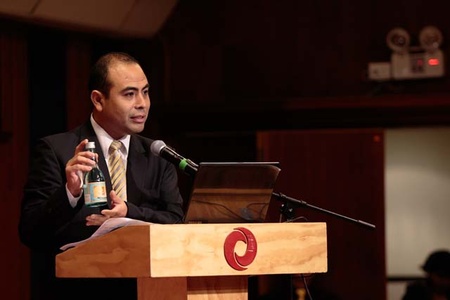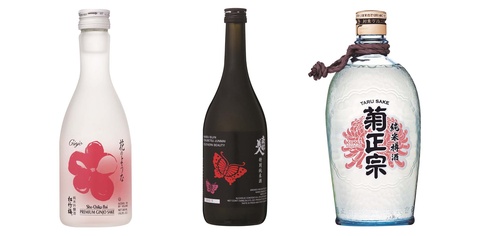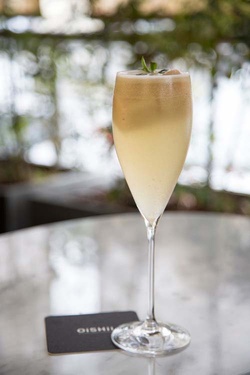A bottle can contain an ancient tradition to take to any corner of the planet. Sake, the emblematic Japanese drink (in fact, its name means that: alcoholic drink, a generic that will later show its variants), has traveled the world captivating those who have discovered something unexpected in it.
Neither a powerful brandy like vodka nor an invasive flavor like that of an anise liqueur. The sake is smooth, without being sweet, delicate and very aromatic, with sweet and floral notes. Some compare it to white wine because of its perfume. Others call it rice beer, which may have little resemblance to the experience you will have in your mouth.
Sake, let's start here, is culture and pleasure. Its history is so old that it dates back to Japanese mythology. The image of the god Kami drinking sake can be found in Shinto shrines, which is why it has been linked to sacredness. For this reason, it is usually drunk at the beginning of a ceremony or before starting a project, from construction to a marriage; and as a sign of offering.
Stories of a drink
Its origin, however, is not so clear. There are those who claim that their manufacturing technique comes from China. The oldest winery that produces sake in Japan was established in the year 1140. Since then it has been produced in the 47 prefectures of the island, in different varieties that use 80 of the 300 varieties of rice that exist in the country.
Abroad, everyone identifies sake as a rice drink, but because its name is generic in Japanese (so it can mean wine, beer, or whiskey, any alcoholic beverage), immigrants have difficulty ordering it in Japan. . To save trouble, you should call it nihonshu and, preferably, order ginjo, which is the best quality.
The quality will depend on the polishing of the rice. Ginjo reaches 60% polishing, one of the highest standards. Some add alcohol to sake, others add fruit flavors (peach, apple, lychee) and can be drunk hot or cold depending on the climate and taste of the palate. “The best sake is the one we like the most, not the most expensive,” says expert Yasuo Ishii.
Cultivation and production
Yasuo Ishii, director of the Super Nikkei company, based in Peru, says that in Japan there are nearly 50,000 brands of sake, produced by about 1,500 wineries. Many of them go to buy the sakamai crops (the variety of rice used in this drink) before they are ready to be harvested to ensure their production.
It is a type of rice that concentrates the starch in the center of each grain, which will be polished until achieving its highest degree of purity. “The more polished the rice is, the higher quality the sake will be,” explains Yasuo Ishii in a talk at the Peruvian Japanese Association, in Lima. Unlike wine, a fungus called koji will be added to rice to ferment it and obtain sugar.
When the process is done in an artisanal way, the drink is called jizake. One of its characteristics is the transparency of the liquid, although you can also get nigori (cloudy sake), explains Ishii, who is a certified advisor by the Sake School of America. Finally, with the remains of the polished rice you can make arare cookies.
Sake without borders
Takao Matsukawa is a certified sake sommelier. He began his career in 1998, in Los Angeles, and since then he has worked with the company Mutual Trading, which exports various varieties to Mexico, Costa Rica, Panama and Chile, among other countries. In Peru, sake entered about 15 years ago and only in the last five years has its demand increased.
“One of the main reasons why sake is not consumed more is due to a lack of information and knowledge,” says Takao, in addition to high tariffs and other taxes that raise its price, unlike what happens in the United States. Among the myths, it is common to believe that it is an intense drink, when its alcohol level is between 14% and 18%, similar to wine (10% to 14%).
The variety of presentations (transparent or colored bottles to protect it from the sun's rays; versions with fruit flavors and the fine art for its presentation) reflect a product that is gaining more and more followers. Even in the United States, some experts have decided to open their own factories in that country, something that also happened in Spain, because it does not have a designation of origin.
Sake and Peruvian cuisine
A year ago, Keisuke Irie and Noriyoshi Nagai, members of the Sake Samurai Association, were in Peru, invited by the Peruvian-Japanese Association, who offered a talk for representatives of restaurants and other establishments interested in the drink. The idea was to show the qualities that make it combine with Peruvian food.

That year, the Peruvian itamae Hajime Kasuga prepared a pairing of Nikkei dishes with various types of sake at the Hanzo restaurant. “It goes very well with Peruvian food, if I had to choose one to serve with sashimi it would be a cold one. With makis with light sauces it can be a medium-bodied sake, but warm, and for a sautéed fish, one with a lot of body.”
Chef Mitsuharu Tsumura, of the Nikkei restaurant Maido (considered the best in its category in Peru by the Summum guide in 2015 and the fifth best in Latin America by the Latin America's 50 Best Restaurants award of the same year), on the other hand, uses it as cooking input in dressings and sauces.
Passing by the bar
Nikkei restaurants have also incorporated sake as an ingredient in their drinks. At Maido, the Punch cocktail has sake, pisco, orange juice, pineapple syrup and white sparkling wine, with exotic fruit juice such as prickly pear, star fruit and mango, to accompany fish and seafood dishes; an initiative that the new premises have adopted.
At Tzuru, a new Nikkei cuisine restaurant opened by Jorge Matsuda and Masa Hamada, for example, they combine it with tonic water, pisco and whiskey, in addition to using leaves to flavor it and togarashi. One of their cocktails is called Sake Lemongrass, which is prepared with lemon verbena, sake and kion.
Oishii, the new restaurant by Japanese Toshiro Konishi, opened this year in Lima, is no stranger to the Nikkei cocktail trend, which is already being talked about in other countries in the region such as Argentina, and even in Europe. There, bartender Anthony Becerra uses sake with Peruvian ingredients (pisco, chuchuhuasi and fruits like pitahaya) and Japanese (lychee and green tea).
The future of sake
In recent years, the Japanese government has intensified its promotion of sake, which was present at the last UN General Assembly and at the Expo Milano 2015 fair in Italy. Although domestic sake consumption has decreased, the product reached its export peak in 2014. The United States is the main market followed by Korea, Taiwan, Hong Kong, Canada and Brazil, says the Samurai Sake Association of Japan.
In Spain, sake has begun to spread through tastings offered by the best wineries in Madrid, Barcelona and Palma de Mallorca. It is a product that can be considered a delicacy at a low price. Suffice it to say that most brands range between $20 and $30, although they can be found from five to $100.
In Peru, the variety of brands allows you to drink traditional sakes, including Ozeki (the classic), which has a light melon flavor; dry and extra dry; those that can be served hot, at no more than 40 degrees (such as the Takara Sho Chiku Bai), the Nigori, which has not been filtered, and the famous ginjo, with a silkier texture. Kampai!
© 2015 Javier Garcia Wong-Kit








